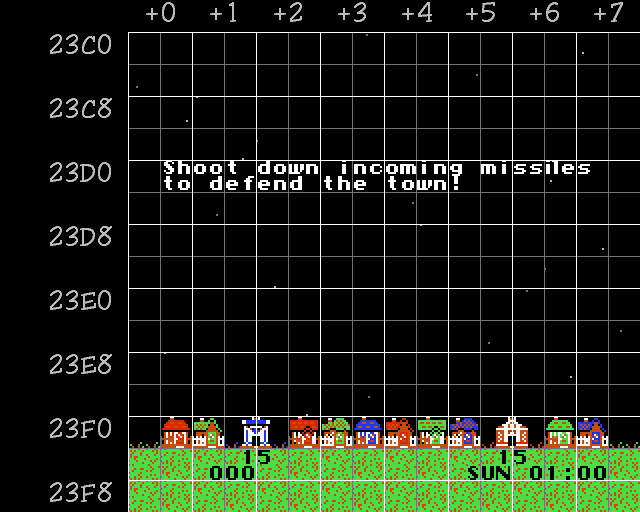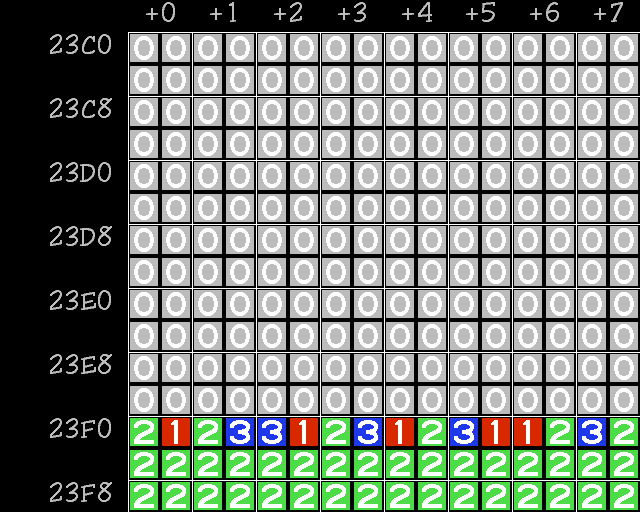PPU attribute tables: Difference between revisions
m (removed redundant links) |
m (Typo. (x by y, not y by x)) |
||
| (17 intermediate revisions by 12 users not shown) | |||
| Line 1: | Line 1: | ||
An '''attribute table''' is a 64-byte array at the end of each [[PPU nametables|nametable]] that controls which palette is assigned to each part of the background. | |||
Each attribute table, starting at $23C0, $27C0, $2BC0, or $2FC0, is arranged as an 8x8 byte array: | Each attribute table, starting at $23C0, $27C0, $2BC0, or $2FC0, is arranged as an 8x8 byte array: | ||
<pre> | <pre> | ||
2xx0 2xx1 2xx2 2xx3 2xx4 2xx5 2xx6 2xx7 | |||
,-------+-------+-------+-------+-------+-------+-------+-------. | ,-------+-------+-------+-------+-------+-------+-------+-------. | ||
| . | . | . | . | . | . | . | . | | | . | . | . | . | . | . | . | . | | ||
| Line 47: | Line 48: | ||
`---+---+---+---' | `---+---+---+---' | ||
</div> | </div> | ||
Each byte controls the palette of a | Each byte controls the palette of a 32×32 pixel or 4×4 tile part of the nametable and is divided into four 2-bit areas. | ||
Each area covers | Each area covers 16×16 pixels or 2×2 tiles, the size of a [?] block in ''Super Mario Bros.'' | ||
Given palette numbers topleft, topright, bottomleft, bottomright, each in the range 0 to 3, the value of the byte is | Given palette numbers topleft, topright, bottomleft, bottomright, each in the range 0 to 3, the value of the byte is | ||
value = ( | value = (bottomright << 6) | (bottomleft << 4) | (topright << 2) | (topleft << 0) | ||
Or equivalently: | |||
7654 3210 | |||
|||| ||++- Color bits 3-2 for top left quadrant of this byte | |||
|||| ++--- Color bits 3-2 for top right quadrant of this byte | |||
||++------ Color bits 3-2 for bottom left quadrant of this byte | |||
++-------- Color bits 3-2 for bottom right quadrant of this byte | |||
Most games for the NES use 16×16 pixel [[metatile]]s (size of ''Super Mario Bros.'' ? block) or 32x32 pixel metatiles (width of '''SMB''' pipe) in order to align the map with the attribute areas. | |||
== Worked example == | |||
<div style="clear: both"> | |||
[[File:Thwaite bg with attr grid.png|frame|center|The background in the game ''[[User:Tepples/Thwaite|Thwaite]]'', with an overlaid attribute grid.]] | |||
[[File:Thwaite attrs.png|frame|center|Each 16x16 pixel color area has one of four subpalettes assigned to it, and one byte controls four color areas.]] | |||
[[File:Thwaite palette color sets.png|frame|center|The background palette has one backdrop color and four three-color subpalettes.]] | |||
Consider the byte at $23F2: | |||
,---- Top left | |||
3 1 - Top right | |||
2 2 - Bottom right | |||
`---- Bottom left | |||
The byte has color set 2 at bottom right, 2 at bottom left, 1 at top right, and 3 at top left. | |||
Thus its attribute is calculated as follows: | |||
value = (bottomright << 6) | (bottomleft << 4) | (topright << 2) | (topleft << 0) | |||
= (2 << 6) | (2 << 4) | (1 << 2) | (3 << 0) | |||
= $80 | $20 | $04 | $03 | |||
= $A7 | |||
</div> | |||
To find the address of an attribute byte corresponding to a nametable address, see: [[PPU scrolling#Tile and attribute fetching|PPU scrolling: Tile and attribute fetching]] | |||
== Glitches == | |||
There are some well-known glitches when rendering attributes in NES and Famicom games. | |||
While an attribute table specifies one of four three-color palettes for each 16x16 pixel region, the left-side clipping window in [[PPU registers|PPUMASK ($2001)]] is only 8 pixels wide. | |||
This is the reason why games that use either horizontal or vertical [[mirroring]] modes for arbitrary-direction [[PPU scrolling|scrolling]] often have color artifacts on one side of the screen (on the right side in ''Super Mario Bros. 3''; on the trailing side of the scroll in ''Kirby's Adventure''; and at the top and bottom in ''Super C''). | |||
The game ''Alfred Chicken'' hides glitches on the left and right sides by using both left clipping and hiding the right side of the screen under solid-colored sprites. To mask the entire 240-scanline height, this approach would occupy 15 entries of 64 in the sprite table in 8x16 sprite mode, or 30 entries in the 8x8 mode. | |||
== Expansion == | |||
There are two bits of memory in the attribute table that control the palette selection for each 16x16 pixel area on the screen. Because the PPU actually fetches that memory redundantly for each 8x1 pixel area as it draws the display, it is possible for a mapper to control this memory and supply different data for each read. The [[MMC5]] mapper does this for its 8x8 extended attribute mode. | |||
Latest revision as of 14:13, 16 January 2024
An attribute table is a 64-byte array at the end of each nametable that controls which palette is assigned to each part of the background.
Each attribute table, starting at $23C0, $27C0, $2BC0, or $2FC0, is arranged as an 8x8 byte array:
2xx0 2xx1 2xx2 2xx3 2xx4 2xx5 2xx6 2xx7
,-------+-------+-------+-------+-------+-------+-------+-------.
| . | . | . | . | . | . | . | . |
2xC0:| - + - | - + - | - + - | - + - | - + - | - + - | - + - | - + - |
| . | . | . | . | . | . | . | . |
+-------+-------+-------+-------+-------+-------+-------+-------+
| . | . | . | . | . | . | . | . |
2xC8:| - + - | - + - | - + - | - + - | - + - | - + - | - + - | - + - |
| . | . | . | . | . | . | . | . |
+-------+-------+-------+-------+-------+-------+-------+-------+
| . | . | . | . | . | . | . | . |
2xD0:| - + - | - + - | - + - | - + - | - + - | - + - | - + - | - + - |
| . | . | . | . | . | . | . | . |
+-------+-------+-------+-------+-------+-------+-------+-------+
| . | . | . | . | . | . | . | . |
2xD8:| - + - | - + - | - + - | - + - | - + - | - + - | - + - | - + - |
| . | . | . | . | . | . | . | . |
+-------+-------+-------+-------+-------+-------+-------+-------+
| . | . | . | . | . | . | . | . |
2xE0:| - + - | - + - | - + - | - + - | - + - | - + - | - + - | - + - |
| . | . | . | . | . | . | . | . |
+-------+-------+-------+-------+-------+-------+-------+-------+
| . | . | . | . | . | . | . | . |
2xE8:| - + - | - + - | - + - | - + - | - + - | - + - | - + - | - + - |
| . | . | . | . | . | . | . | . |
+-------+-------+-------+-------+-------+-------+-------+-------+
| . | . | . | . | . | . | . | . |
2xF0:| - + - | - + - | - + - | - + - | - + - | - + - | - + - | - + - |
| . | . | . | . | . | . | . | . |
+-------+-------+-------+-------+-------+-------+-------+-------+
2xF8:| . | . | . | . | . | . | . | . |
`-------+-------+-------+-------+-------+-------+-------+-------'
,---+---+---+---. | | | | | + D1-D0 + D3-D2 + | | | | | +---+---+---+---+ | | | | | + D5-D4 + D7-D6 + | | | | | `---+---+---+---'
Each byte controls the palette of a 32×32 pixel or 4×4 tile part of the nametable and is divided into four 2-bit areas. Each area covers 16×16 pixels or 2×2 tiles, the size of a [?] block in Super Mario Bros. Given palette numbers topleft, topright, bottomleft, bottomright, each in the range 0 to 3, the value of the byte is
value = (bottomright << 6) | (bottomleft << 4) | (topright << 2) | (topleft << 0)
Or equivalently:
7654 3210 |||| ||++- Color bits 3-2 for top left quadrant of this byte |||| ++--- Color bits 3-2 for top right quadrant of this byte ||++------ Color bits 3-2 for bottom left quadrant of this byte ++-------- Color bits 3-2 for bottom right quadrant of this byte
Most games for the NES use 16×16 pixel metatiles (size of Super Mario Bros. ? block) or 32x32 pixel metatiles (width of SMB pipe) in order to align the map with the attribute areas.
Worked example

Consider the byte at $23F2:
,---- Top left 3 1 - Top right 2 2 - Bottom right `---- Bottom left
The byte has color set 2 at bottom right, 2 at bottom left, 1 at top right, and 3 at top left. Thus its attribute is calculated as follows:
value = (bottomright << 6) | (bottomleft << 4) | (topright << 2) | (topleft << 0)
= (2 << 6) | (2 << 4) | (1 << 2) | (3 << 0)
= $80 | $20 | $04 | $03
= $A7
To find the address of an attribute byte corresponding to a nametable address, see: PPU scrolling: Tile and attribute fetching
Glitches
There are some well-known glitches when rendering attributes in NES and Famicom games.
While an attribute table specifies one of four three-color palettes for each 16x16 pixel region, the left-side clipping window in PPUMASK ($2001) is only 8 pixels wide.
This is the reason why games that use either horizontal or vertical mirroring modes for arbitrary-direction scrolling often have color artifacts on one side of the screen (on the right side in Super Mario Bros. 3; on the trailing side of the scroll in Kirby's Adventure; and at the top and bottom in Super C).
The game Alfred Chicken hides glitches on the left and right sides by using both left clipping and hiding the right side of the screen under solid-colored sprites. To mask the entire 240-scanline height, this approach would occupy 15 entries of 64 in the sprite table in 8x16 sprite mode, or 30 entries in the 8x8 mode.
Expansion
There are two bits of memory in the attribute table that control the palette selection for each 16x16 pixel area on the screen. Because the PPU actually fetches that memory redundantly for each 8x1 pixel area as it draws the display, it is possible for a mapper to control this memory and supply different data for each read. The MMC5 mapper does this for its 8x8 extended attribute mode.

